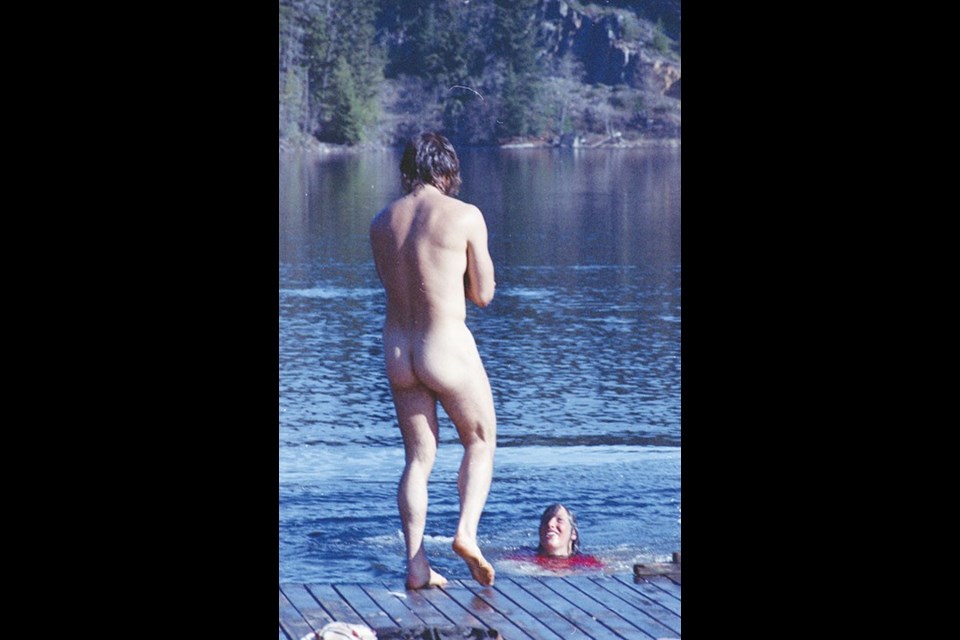In a scene from the 1908 children's novel, The Wind in the Willows, the central character of Mr. Toad — a wealthy anthropomorphic animal with a penchant for fast cars and tweed suits — hums a tune to a rapt audience that exists only in his mind.
The lyrics of this little ditty perfectly capture the reckless abandon with which Mr. Toad lived his life: He boasts of smashing a window and crashing in a door, of vexing a group of weary weasels to the point of fainting. Yet, despite his churlish behaviour, Mr. Toad feels no need to apologize, instead clamouring for a hero's welcome — Let each one of the crowd try and shout it very loud, in honour of an animal of whom you're justly proud.
It's the kind of beguiling, devil-may-care attitude that was so engrained into one of Whistler's most infamous hippie haunts, Toad Hall, a Bavarian-style cabin on the shores of Nita Lake that was named after the titular amphibian's beloved homestead.
And although the original hall's position as a come-one, come-all flophouse throughout those heady years of the late '60s would be short lived, the free-spiritedness of this countercultural haven would live on through another popular hangout of the time, and ultimately, a lasting image that came to encapsulate that era of Whistler's past so perfectly.
It's a picture anyone who's spent enough time here has seen; 14 young and carefree beatniks posed in nothing but their ratty ski gear and knowing smiles in front of a beat-up cabin set for demolition.
It's an image that still endures as one of the most iconic in Whistler's history. So, 42 years later, the following oral history has been weaved together through several interviews, as well as excerpts from the Whistler Museum's Whistorical blog and Pique's special 2000 publication, Whistler: History in the Making.
Toad lives on.
Interviews have been edited for length and clarity.

The original Toad Hall
Sarah Drewery (Former executive director of the Whistler Museum): The building itself (which was not called Toad Hall at the time) was built by a logger, Alf Gebhart, who first moved here in 1936.
John Hetherington (Resident of original Toad Hall location on Nita Lake): I think Gebhart built the house to be his retirement home, but his wife hated it because it was so cold and dark. So they abandoned the place.
There was a full basement to it, and the walls of the basement had apparently been built by some Scottish mason. They were substantial enough to hold a castle. But to heat the place, it'd have needed to hold the sun.
Drewery: In the mid-'60s Alf sold his cabin to Charles Hillman, a teacher from Ontario who was working in a high school in Vancouver. Charles rented it to a respectable-looking divorced father with two daughters. The rent kept coming in, but as time went on the cheques mysteriously began to bear different names to the man he had originally rented to. When Charles was ready to use the cabin for himself to ski on Whistler Mountain, he discovered, to his horror, that it had become a squat and renamed 'Toad Hall.'
Hetherington: At the beginning, when there was just four of us living there, we were all working at Whistler Mountain, so there was no problem. But over time different people moved in.
Occasionally we'd have a party and everybody in the valley would show up. There weren't that many people living here back then — I figure about 150. It started to acquire this reputation and it went beyond all bounds. It became almost mythical.
Brad Nichols (Executive director of the Whistler Museum): Toad Hall was the embodiment of young, free-spirited ideas and living differently from the norm. I think a lot of people came to experience that.
Hetherington: In the springtime, you'd get up in the morning and find there'd be people sleeping on the living room floor. They'd heard about this place, managed to find it and figured they were entitled to stay there. It was my job to kick them out. I think they appointed me because I was the smallest guy.
Drewery: The squatters slept everywhere — in the chicken house, sheds and shoulder-to-shoulder on the floor. To finally get possession of his own place, Charles, with the assistance of the police from Squamish, entered his Nita Lake home with a court order for the squatters to leave. The eviction seemed to be fairly amicable however, as Charles even granted them an extension so they could have a big farewell party.
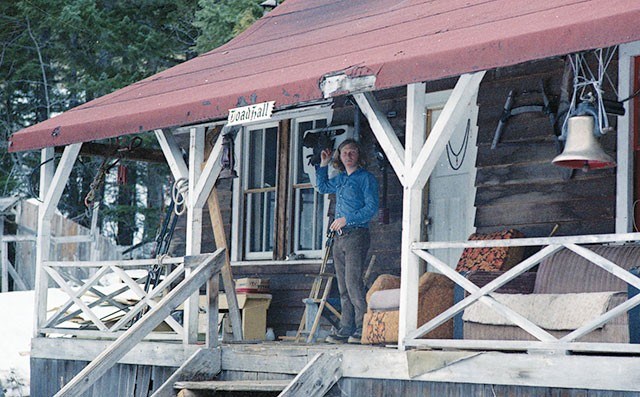
A new home for the homeless
Evicted from their lakeside Eden, the longhaired hippies, burners and ski bums existing on the fringes of the community — both literally and figuratively — were officially homeless. But, as was the case for many of the resilient Whistlerites of the time, flying by the seat of one's pants — on the rare occasions pants were worn — was not unusual, and before long, the squatters found their new mountain mecca in the Soo Valley: an abandoned lumber mill on the north end of Green Lake.
Toad Hall would have its renaissance.
Hetherington: The Soo Valley, where that photo was taken, I think there were a dozen or so buildings and that was the main house. But there were a bunch of other houses that ranged from roughhouses down to shacks. Every one of them was occupied.
Paul Mathews (Appears in Toad Hall photo fourth from the left): I would argue that Soo Valley was the precedent for Whistler Village. We had the group of 13 cabins, a pedestrian zone — the whole thing.
Terry "Toulouse" Spence (Appears in Toad Hall photo fourth from the right): The idea was that you could live and ski in Whistler and rent wasn't costly. The rent was quite minimal. In fact I can't even remember paying rent. I think I must've had to pay something, but nobody was gunning me for it.
Mayor Nancy Wilhelm-Morden (Moved to Whistler in 1973): Every place back in those days where people in their early 20's congregated had a real kind of special feeling about it. We were all young and relaxed. Some were working, others weren't.
Mathews: The main house was where we tended to have group dinners, and transients would come. There were three or four bedrooms that the transients could come through, and we had a kitchen, and that's where we'd have meetings, discussions, parties and group dinners — which happened once or twice a week.
Hetherington: There were some phenomenal parties there. There was the annual Soo Valley party every May. Those parties would go on for three days and everybody wanted to go. Bands used to come down from Vancouver and play for free just to be part of the party.
Jorge Alvarez(Founded Toad Hall Studios, Whistler's original silkscreening print shop, in 1989): For years I always admired Toad Hall. It was the original ski-bum central where people would smoke doobs, do acid and run around naked. This was before there were cops in town, when the liquor store was in a trailer.
Drew Tait (Appears in Toad Hall photo sixth from the left): You know that Whistler used to be called Alta Lake, B.C., right? Well the B.C. didn't stand for British Columbia; it stood for 'Before Cops.' There weren't too many of them in those days.
Hetherington: If you came into the party there might be some police up on the highway, but they dared not go down to the party zone. They just wanted to keep control of the traffic and make sure nobody was driving drunk.
Spence: (Weekend Magazine) came to Whistler at the time and wrote a story about Soo Valley and Toad Hall and they said... there was non-stop partying and a drunken festival everyday. (Toad Hall poster photographer) Chris Speedie and I would rush home after skiing and see when the party was going to start, but they were wrong. It was way over-exaggerated. Writers — and I hope you're not a sensationalist — they tend to do that. They sensationalized the whole atmosphere. We had parties down there, sure, we had some really great parties. But we had some disasters, too: A guy drowned after a party. He fell in the Green River and he drowned. It was not always a happy thing down there.

Damn hippies
Hetherington: There were some of us who weren't especially appreciated by various powers that be and some of the people that lived here. I understand that.
G.D. Maxwell (Writer, Pique columnist): The Alta Lake Housing Society knew about the people and the parties at Soo Valley and weren't particularly impressed with either.
Spence: I think the Alta Lake Ratepayers Association didn't really like us. I guess we looked a little different; we all had long hair. We were hippies in many ways, but we shopped and drank and we were the locals here.
Mathews: There was friction between the hippies and mainstream culture in those days, and that existed here to some extent, but not nearly as bad as in downtown Vancouver or Seattle.
Funnily enough we got along very well with the older segment, like (Whistler pioneers) Florence Petersen and Myrtle Philip. But I think (Whistler Mountain founding father) Franz Wilhelmsen and some of the guys in the Garibaldi Lift Company weren't real thrilled with us. Some guys had fraudulent passes and that's not a good thing. I didn't, I was legit.

The making of an iconic image
Drewery: Without going into too much detail, let's just say that by the spring of 1973, tales of debauchery left local powers wholly unenthused with this shag-carpeted Shangri-La. Toad Hall was slated for demolition later that summer.
Mathews: It was a sunny, May morning in 1973. Even though Green Lake is quite cold, it was sunny and we were nude to go swimming. Everyone hung around nude anyway.

Tait: I was sitting there drinking beer and as everybody got up, I said, 'I need you to help me drink this beer so we can bottle more.' Pretty soon we had a whole bunch of people drinking beer, and then everybody else came around to see what was going on. Then Terry and Speedie said, 'Well, whiles we're together, let's take a picture. And as long as we're taking our picture, let's take our clothes off.' So we did.
Spence: At that time it wasn't really important to be dressed, you know? We had a lot of parties at Tokum Corners and Toad Hall where people were quite comfortable walking around with their clothes off. (The photo) was an interesting idea. We just wanted to tweak the noses of everybody. We had no idea what we were going to do with the picture. Speedie just wanted a picture of everybody and he thought a nude picture would be kind of fun.
Tait: I didn't have any apprehension about posing nude. Those were the days. Chris Speedie was talking to the cops one time and they said, 'You guys aren't bad guys, you just need to clean up your act.' And Speedie said, 'Clean up our act? You're lucky we put our clothes back on.'
Spence: I don't think anyone had any hesitation over it. It's quite innocent, to tell the truth. It's not suggestive at all — it's actually kinda funny.
Wilhelm-Morden: I think I may be in other kinds of compromising photos from back in the day. But that photo was taken before I arrived (in Whistler) ... We all had our clothes on by the time I got here. (laughs)
Mathews: We were told by Chris Speedie to line up with ski gear and take a picture. We didn't think much of it at the time.
Hetherington: When you look at the photo, it's sort of weird.
Spence: This was one of those things that was just a shot in the dark. We took a lot of pictures — I've still got the negs. We took shots of people facing backwards, away from the camera — we took more than one. Speedie set it up and we had a guy named Kiwi press the plunger and shoot the photo.
Drewery: Sensing the image's iconic potential, a few 'Toadies' scrounged together some cash and printed off 10,000 posters.
Spence: It cost us a couple grand to do it. What we would do after we got the posters was go down to Dusty's on a Saturday or Sunday and sell them for $2 each. People would be drinking in there and they'd be in a good mood after a day of skiing, see the poster and laugh. We would sell as many as we could until we had enough money, and then we'd join the drinkers. It was pocket money.
Mathews: It covered Terry Spence's living expenses selling those things... for several years at least. Toulouse was sort of the ringleader of the whole thing, as he was the instigator of many things in our lives.
Spence: We took it to Kimberley and there was a different kind of attitude there. They didn't see the humour in it that much and we didn't sell that many there. I also took some down to Sun Valley and people didn't see the humour in it there, either. Maybe we were ahead of our time a little bit.
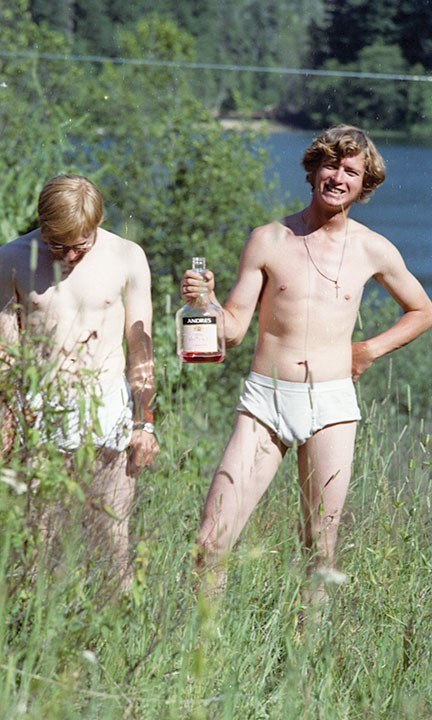
Drewery: During the height of the Crazy Canuck era, Toulouse brought boxes of posters along for the ride on the World Cup ski circuit. To this day it can still be found decorating the walls of some of the world's most cherished ski bars.
Spence: When I worked with the national ski team, I took them over to (Austria) and the guy from the Londoner pub loved them. He would buy a hundred off me every year. That covered my drinking expenses over there.
Mathews: As a matter of fact I've gone into the Londoner pub in Kitzbühel, Austria, where anyone in that photo gets free beers — and they honoured it. This was probably '87 or '88.
Spence: People have recreated it. People in Europe have done it — I can't keep track of all of them. It's been awesome.
Tait: I always get a kick out of people saying they're in the picture when I know they're not.
Drewery: The poster simply provides an unencumbered gaze back in time at early Whistler's carefree lifestyle. And yes, some of the 'models' still call Whistler home, but good luck getting any of them to admit it!
Spence: There's one guy in the poster who's currently a banker, and I had a business venture at one time and went down to see him in the bank to get a loan. I had a tube of posters with me, and he asked me what they were. I told them they were the (Toad Hall) posters and he asked me what I brought them down for. I said, 'Well just in case I didn't get the loan, I was going to pass them off to your staff.' I got the loan even before I had to do that.
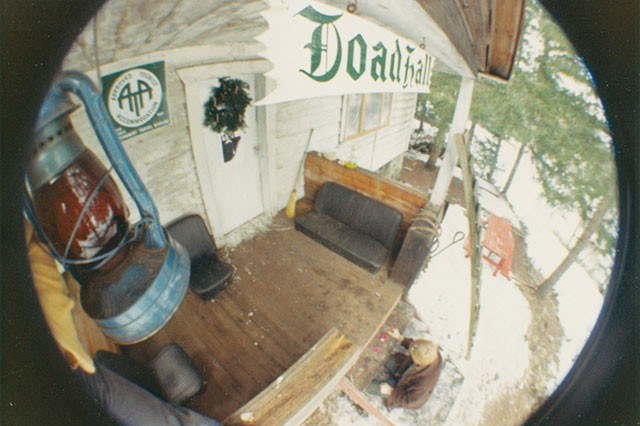
A Revealing Legacy
Mathews: I don't really know why the photo has endured for so long. We were ski bums and that was a perfect picture of what a ski bum looked like: Long hair, no clothes and old ski equipment. It's funny that it's endured so long.
Dawn MacLeod (Daughter of Rod MacLeod, regular Toad Hall frequenter): It's an iconic photo and there's an innocence about it, if you can call a naked photo innocent. It was just a bunch of young kids who thought it would be a good idea. It probably took five minutes to do, and it's gone around the world.
Spence: Of course I'm proud of the photo. It's a little bit of Whistler history that people keep touching on.
Nichols: I think it hit the nerve. The photo (represents) a free spiritedness and why people want to come to Whistler. A lot of older people like it because I think it represents a time when it was almost like the Wild West here.
Mathews: It's a good piece of nostalgia and there are a lot of people today who were around then — even Nancy Wilhelm-Morden lived at another hippie camp. I don't think it's just us hanging onto the past though; I think it has struck a chord with other people as well.
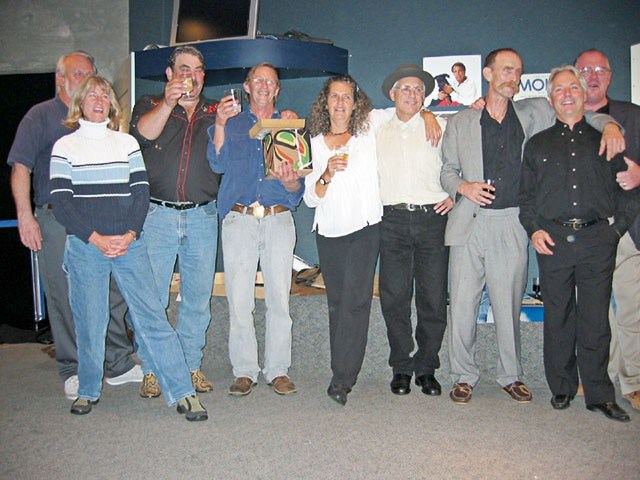
Wilhelm-Morden: It really just captured the feel of the place, and those of us who were around in those days still very much remember that feel.
Hetherington: That photograph represents the early times in Whistler, and a lot of us who lived through those early times tell stories about it. People here were pretty free, the skiing was fabulous and it's got this very romantic aura about it now. I think that old feeling is still here, especially among young people who come here, because there's so much happening.
Mathews: Sure, I miss that era. You know what though? Whistler's still a pretty good place to live. We've never developed that snobbish attitude that Vail and Aspen have. I think that's in our DNA right to our current mayor. Myself and Terry and many leaders in the community have kept the principle of it. We're not quite as young to do the things we did in those days. It's a fond memory. If I could go back and be that age and do it all over again, I'd love to do it.
Spence: Whenever I get together with friends at birthdays and that, we talk about that time, and it was a lot of fun. But, you know, I'm 73 years old now, and you can never go back. What Whistler has evolved into is a great success. I can't imagine (Whistler Blackcomb president) Dave Brownlie has my picture up on his office wall, but I'm not worried about that.
Tait: Toad Hall was about all our friends. Just a pile of friends, that's all. It's like I tell all the young people in town that I work with: Beware of the friends you make in your 20s because a lot of them will be your friends for life.
Prints of the Toad Hall poster are available for purchase at the Whistler Museum for $20.

